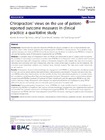Chiropractors’ views on the use of patient-reported outcome measures in clinical practice: a qualitative study

Abstract
Background: Patient-reported outcome measures (PROMs) are widely available for use in musculoskeletal care. However, there is little research exploring the implementation of PROMs in clinical practice. This qualitative study explored chiropractors’ views on PROMs to identify any barriers and facilitators to implementing PROMs in chiropractic care and the training needs of chiropractors regarding the use of PROMs.
Methods: A qualitative study of chiropractors’ views on PROMs was undertaken as part of a larger project to address the feasibility of conducting a randomised controlled trial of PROM use in chiropractic clinics for patients with low back pain. Contact was made with chiropractors working in chiropractic companies with multiple clinic sites. Semi-structured interviews were conducted with eight chiropractors, either face-to-face at their place of work or over the telephone. The interviews were transcribed verbatim and analysed using thematic analysis. The data were coded inductively by two authors.
Results: Chiropractors discussed their knowledge and engagement with PROMs in clinical practice, identifying reasons for their use, such as understanding clinic performance, clinical practice, and research. They also discussed how they used PROMs within their clinical practice and the benefits of using them with individual patients, for example during the consultation, identifying yellow flags, and tracking patient progress. Chiropractors voiced concerns about patient engagement with PROMs, questioning if patients find them burdensome, and the appropriate PROMs to use with patients with pain. Finally, chiropractors acknowledged the organisational barriers and facilitators to using PROMs within their practice, such as busy practices, electronic systems, and use of reception staff.
Conclusions: Using participating chiropractors’ views of PROMs, the study identified barriers and facilitators to implementing PROMs in chiropractic care, such as clinician knowledge, engagement, and organisational concerns and identified the potential training needs of chiropractors regarding PROMs. The results from the study suggested chiropractors use PROMs with their individual patients, but PROMs should be meaningful to patients and chiropractors to improve engagement.
Collections
Date
2018Author
Holmes, Michelle
Bishop, Felicity L
Newell, Dave
Field, Jonathan
Lewith, George